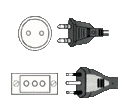
Chile’s position between the Andes and the Pacific fosters several micro-climatic zones. Your packing list will vary depending on the regions you are travelling to. The north is desert, warm during the day but very cool at night. Santiago and the Central Valley enjoy a Mediterranean climate. The south is cold, bitterly so in winter, and often wet.
The north, which contains the Atacama Desert, is characterized by hot and arid weather. Summer temperatures from December to February in this region can reach 38°C (100°F) and can drop dramatically to -2 °C (30°F) during the night. Winter days, from mid-June to late August, are crisp in the sunshine but bitterly cold in the shade and when the sun sets. Along the coast, the weather is mild and dry, ranging from 16°C-32°C (60°F to 90°F). Although classified as the driest desert in the world, it is possible to experience heavy rainfall from the end of January through February.
he central zone extending about 1,450 km (900 mi) has seasons that are better defined. Temperatures in this region range from 0°C to 13°C (32°F - 55°F) in the winter, and 16°C to 35°C (60°F - 95°F) during the summer. The summer months December to February can be hot and crowded in Valparaiso and the wine regions due to the annual holidays. Rainfall is heaviest in the winter months but still only moderate and falling on a few days at this time.
The weather is extremely erratic in Patagonia. In the summer and prime time (from October to March) you can expect some warm sunny weather, as well as cold, rainy, and windy days. Weather changes in a matter of minutes and returns to sunshine just as quickly. Wind is the one consistent factor in Patagonian weather. Windstorms can reach upward of 120kmph (74 mph), and it’s not unusual to experience heavy rain during the summer. The windiest months are from mid-December to early February, but it can blow any time between October and April. Winters are calm, with irregular snowfall and temperatures that can drop to -15°C (5°F). when you get chilled. You want your inner layer to be wicking (no cotton). Next layer should be insulating and warm, and the top layer should be waterproof/breathable. The winter months, July and August, can be extremely cold and facilities sometimes shut down.
The climate is moist and there is sporadic rain, which becomes more intense in May. While it rarely gets any hotter than 29°C (85°F), it can feel very muggy and uncomfortable in the Austral summer (December through March). February is the hottest month and at the same time the month in which Easter Island’s largest festival Tapati takes place for about 2 weeks. Winters are mild, with a low of around 14°C (57°F). Heavy rainfall and storms occasionally hit the island in July and August, which are the coolest months.
This is the region of snowcapped volcanoes, deep blue mountain lakes, pristine beauty of larch forests, popular resorts, and legends. The Lake District has pleasant but changeable summer weather and cool winters. The months of June to September (winter) are the best time for snow-based activities and skiing. Wintertime temperatures average 7°C (45°F). Spring and summer, from November to April, are drier months than the winter months, but expect rain at any time and take your wet weather gear regardless of when you decide to stay. Average temperatures in summer are 18 to 23°C (65 to 73°F).
It's important to note that Chile is a long and geographically diverse country, and regional climates can vary significantly. Considering that Santiago de Chile, San Pedro de Atacama and Patagonia are the most visited destinations March is an ideal month to visit Chile.
Chile is served by three major mobile network operators that offer 5G services:
Among them, Entel has consistently been recognized for providing the best network quality. When traveling throughout the country, reliable coverage becomes crucial, especially in remote areas like Easter Island. As of June 2023, Entel has extended its 5G coverage to Easter Island using satellite internet technology, albeit at slower speeds compared to major cities. Movistar offers good quality of network at affordable prices.
To obtain a prepaid SIM card package, you can visit the physical stores of mobile providers, as well as supermarkets, malls, and kiosks. When you need to recharge your prepaid SIM card, simply ask for a ‘recarga’.
Please note that as of June 2023, it is not possible to purchase a prepaid SIM card at the international airport in Santiago de Chile. However, if you are in a hurry and have a device compatible with e-SIM, you can visit a very user-friendly website:
They offer step-by-step instructions on how to activate and purchase an e-SIM. Holafly uses the Movistar network in Chile.
Entel also provides e-SIM cards, but this option requires a visit to one of their physical stores.

